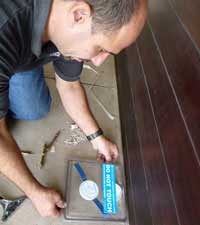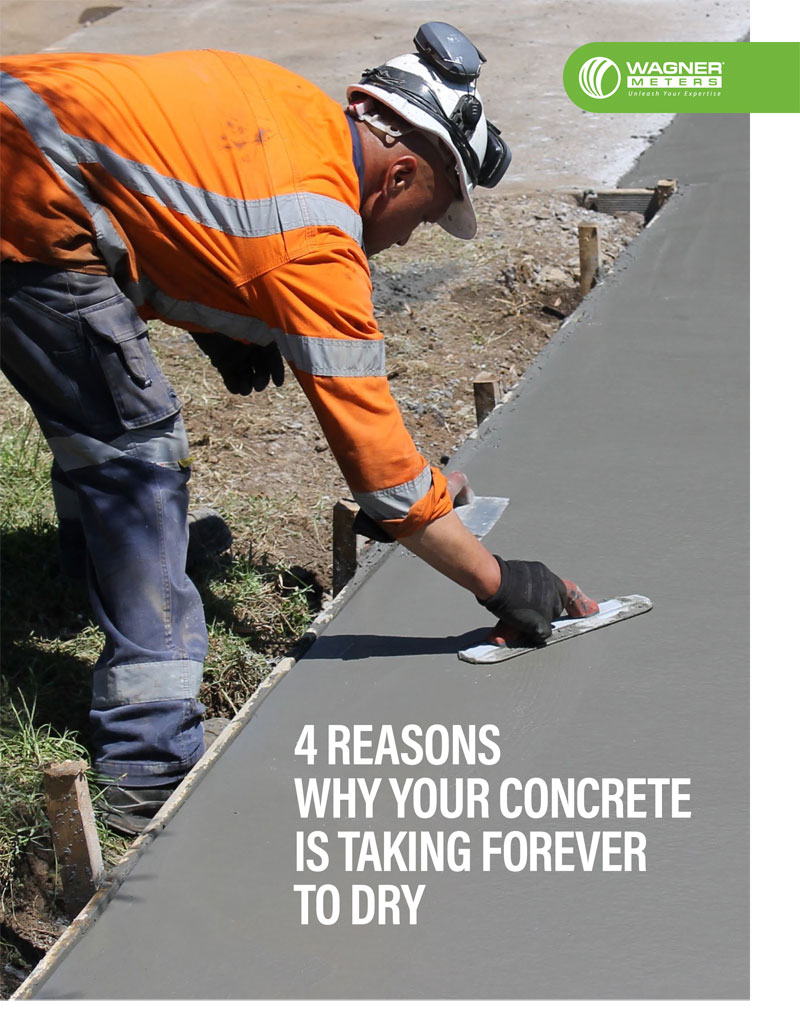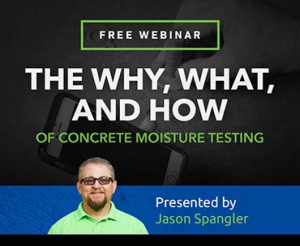MVER Testing is Only Skin Deep
When determining if a concrete slab is ready for finishing, flooring, or occupancy, testing the relative humidity (RH) and moisture vapor emission rate (MVER) are two commonly used methods.
However, many professionals wonder if there is a correlation between RH and MVER.
In this article, we will explore the differences between these two tests and shed light on their merits.
- Moisture Vapor Emissions Rate (MVER)
- Relative Humidity (RH)
- RH and MVER Tests: Is There a Correlation?
- Surface Similarities
- Deep Down Differences
- The Rapid RH
Whether it’s wood or concrete construction, knowledge empowers all players to assess moisture content for optimum results.
Moisture Vapor Emissions Rate (MVER)
Commonly called the calcium chloride test, MVER is a traditional measure of concrete moisture content. Due to its longevity, building contractors still use it.
However, installers had used calcium chloride to measure concrete moisture content for decades without any real sense of the science (or lack thereof) behind it.
MVER reads the pounds of water per thousand square feet per 24 hours of drying. Most manufacturers recommend readings of between “3” and “5.”
Calcium chloride fails to address the moisture measurement technology that has developed in recent years. While MVER testing estimates concrete moisture content to a very limited depth, it is imprecise. Calcium chloride only measures surface concrete conditions. Building projects continue to be defined by time constraints and budget.
Accordingly, installers utilize more curing, sealing, and bond-breaking compounds to speed up the process. This is anathema to calcium chloride. An MVER reading depends on the absence of exactly those compounds that builders increasingly use.
Therefore, calcium chloride assessment has become passé in construction and, in fact, has been disallowed for certain concrete applications.

Relative Humidity (RH)
Testing for RH provides a statement of overall moisture content in concrete. Because the RH in situ probes take their readings at a 40% depth, an equilibration moisture content can be determined.
Building contractors and building inspectors conduct RH tests to determine the proportional presence of moisture content throughout a concrete slab. The RH test of moisture content via in situ probes is a certified method of satisfying ASTM Standard F2170.
An RH test is deployed to identify variations in moisture content in a body of building material which needs to reach a specified moisture content. Industry uses the RH test method for continuous spots checks during a building process. Concrete builders deploy RH tests at multiple locations on a slab to determine its drying status.
Put simply, RH tests scrutinize the interactive relationship between moisture content of building materials and the RH of its surroundings. Building contractors apply RH tests by implanting in situ probes in the slab.
Done repeatedly, building contractors can build data libraries which indicate the eventual onset of equilibrated moisture content (EMC). This data would certainly interest building inspectors.
RH and MVER Tests: Is There a Correlation?
When looking to determine if a concrete slab is dry enough to proceed with a finish, flooring or occupancy, there are several methods commonly specified for testing the relative humidity (or moisture condition) of the slab.
A dry slab is never at 0% humidity, but determining the level of moisture still held in the concrete can be the difference between a successful flooring installation and a problem-prone floor system.
The two most frequent test methods specified in the industry today are Moisture Vapor Emission Rate (MVER) testing (with results expressed as pounds/1000 square feet) and relative humidity (RH) testing with in situ probes (with results expressed as a percentage).
When faced with the two options, contractors, and other industry professionals often ask, “What is the correlation between RH and MVER?”
Simply stated…there isn’t one.
While it might seem logical that there would be some relationship between the two, the reality is that there is nothing more than an imprecise use of the term “moisture test” that links the two test methods.
Surface Similarities
Beginning around the 1940s, moisture levels were tested by placing an enclosed amount of desiccant on a slab’s surface for a period of time. Calcium chloride, or CaCl, was the most common desiccant used for this type of moisture testing and it is often referred to as the anhydrous calcium chloride test.
Any subsequent change to the weight of the desiccant was thought to indicate the amount of water vapor that had left the slab to be absorbed by the desiccant. That weight was represented as a ratio of the total moisture content within the slab, and is referred to as MVER, expressed in terms of “pounds/1000 square feet.”

Extensive research done by the CTLGroup in the 1990s showed several problems with the CaCl test:
- MVER test kits cannot be calibrated.
- The test measures, at most, the top ½ – ¾ inch of the slab, but not deeper.
- Surface treatment, including trowelling practices, curing agents, ambient conditions and more, can skew MVER test results. In fact, calcium chloride testing has been specifically disallowed for lightweight concrete applications because the lightweight aggregate can impact results for false high or low results.
- The limits set for the test (i.e. 3 lbs/1000 sq ft) were somewhat arbitrarily chosen and published.
- There is no scientific backing for the test method as either a qualitative or a quantitative measure of concrete moisture. (1)
The real difficulty of MVER or CaCl testing lies in the fact that it primarily tests only the surface conditions of the slab. Drying concrete tends to have a gradient effect – moisture levels are higher deeper in the slab.
As moisture evaporates from the surface of the drying slab, it then allows additional moisture to rise through the natural capillaries of the concrete in a progressive cycle until the moisture content in the slab reaches a balance with conditions around it. MVER is incapable of providing accurate readings of those internal levels.
A traditional “moisture test,” MVER is still regulated by ASTM F1869. Ultimately, though, it has proven to be an unscientific and problematic test method, plagued by subsequent moisture-related flooring problems.
Deep Down Differences
RH testing for concrete, on the other hand, measures internal moisture levels of a concrete slab by placing sensors, or in situ probes, within the concrete slab itself.
Testing that had begun in Sweden and elsewhere in the 1990s demonstrated that for slabs that dried from one side, placing the probes at 40% of the slab depth would give a reading that would reflect accurate moisture conditions of the slab if it were sealed (i.e. a floor covering installed) at that point in time.
(For slabs drying from two sides, the correct depth is 20% of the slab depth.)
Based on the realities of moisture vapor’s distribution in drying concrete, RH testing can accurately determine the internal moisture levels, or RH, of the concrete.

Free Download – 4 Reasons Why Your Concrete Is Taking Forever to Dry
Understandably, the difference between MVER and RH testing has had a significant impact on the flooring industry. Allowing concrete and flooring installers to make informed decisions when choosing products that will tolerate the actual RH levels of the slab, or allowing them to make remediation choices before elevated moisture levels result in flooring problems.
As concrete science changes with the additions of admixtures, new aggregates, and a variety of finish options in demand, RH testing continues to provide accurate concrete moisture measurement for industry professionals.

The Rapid RH®
With the solid research in RH testing as its basis, Wagner Meters’ Rapid RH® products stand at the lead in innovative, field-tested RH testing. The Rapid RH® Smart Sensors and companion Total Reader make the Rapid RH® among the fastest, most accurate and cost-effective RH test systems on the market today.
Its award-winning innovation and practical design offer flooring experts and concrete professionals the technology to keep fast, experienced and accurate data at their fingertips for all of their business, reporting and scheduling decisions when installing floors that will last a lifetime.
The Rapid RH® is the latest in field-tested, scientifically-backed, industry-proven RH testing for concrete and flooring professionals.
You can learn more about RH testing and the Rapid RH®.
Take a free webinar on RH testing for concrete floors.

Jason has 20+ years’ experience in sales and sales management in a spectrum of industries and has successfully launched a variety of products to the market, including the original Rapid RH® concrete moisture tests. He currently works with Wagner Meters as our Rapid RH® product sales manager.
Last updated on February 18th, 2025



